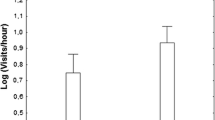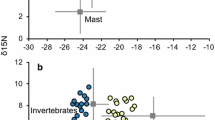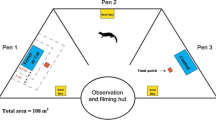Abstract
Individuals manage their risk of predation in different ways in different situations. We studied the use of anti-predator behavior by Western Sandpipers (Calidris mauri) at Bahía Santa María, northwestern Mexico, foraging in three habitats that differed in presumed predation danger. Brackish flats are completely open, making them theoretically less dangerous for feeding sandpipers than mangroves and cattail marshes, which have closer visual horizons. Western Sandpipers are sexually dimorphic, with females about 15% longer-billed and 10% heavier than males. We previously showed that male and female sandpipers differed in their habitat choice and relative body mass in ways consistent with differential responses to predation danger (Fernández and Lank in Condor 108:547–557, 2006). Contrary to expectations, however, females were overrepresented in more dangerous habitats. Here, we examine differential usage across habitats and between the sexes of three anti-predator tactics—flock size, density within flocks, and vigilance rate—that may be used cumulatively to reinforce safety, or as trade-offs that compensate for levels of usage of each. We hypothesized, and found, that ordered differences occur among habitats, and that controlling for other factors, females were more cautious than males. For the most part, the use of these three tactics appeared to be cumulative, rather than compensatory. However, with respect to habitat use, birds appeared to compensate for the higher probability of mortality intrinsic to the use of higher-danger habitats by increasing the use of vigilance, foraging in tighter flocks, and maintaining lighter body weights (females only). Thus, both cumulative and compensatory processes operate among anti-predator tactics to determine the net level of safety and trade-off against other factors.

Similar content being viewed by others
References
Altmann J (1974) Observational study of behavior: sampling methods. Behaviour 49:227–264
Barbosa A (1995) Foraging strategies and their influence on scanning and flocking behaviour of waders. J Avian Biol 26:182–186
Barbosa A (1997) The effects of predation risk on scanning and flocking behavior in dunlin. J Field Ornithol 68:607–612
Beauchamp G, Ruxton GD (2008) Disentangling risk dilution and collective detection in the antipredator vigilance of semipalmated sandpipers in flocks. Anim Behav 75:1837–1842
Bijlsma RG (1990) Predation by large falcons on wintering waders on the Banc d’Arguin, Mauritania. Ardea 78:75–82
Burns JG, Ydenberg RC (2002) The effects of wing loading and gender on the escape flights of least sandpipers (Calidris minutilla) and western sandpipers (Calidris mauri). Behav Ecol Sociobiol 52:128–136
Cartar RV (1984) A morphometric comparison of western and semipalmated sandpipers. Wilson Bull 96:277–286
Childress MJ, Lung MA (2003) Predation risk, gender and the group size effect: does elk vigilance depend upon the behaviour of conspecifics? Anim Behav 66:389–398
Clark CW (1994) Antipredator behavior and the asset-protection principle. Behav Ecol 5:159–170
Cresswell W (1994a) Age-dependent choice of redshank (Tringa totanus) feeding location: profitability or risk? J Anim Ecol 63:589–600
Cresswell W (1994b) Flocking is an effective anti-predation strategy in redshank, Tringa totanus. Anim Behav 47:433–442
Cresswell W (1996) Surprise as a winter hunting strategy in sparrowhawks Accipiter nisus, peregrine falcon Falco peregrinus and merlins F. columbarius. Ibis 138:684–692
Cresswell W (2008) Non-lethal effects of predation in birds. Ibis 150:3–17
Cresswell W, Whitfield DP (1994) The effects of raptor predation on wintering wader populations at the Tyninghame estuary, southeast Scotland. Ibis 136:223–232
Cresswell W, Quinn JL, Whittingham MJ, Butler S (2003) Good foragers can also be good at detecting predators. Proc R Soc Lond B 207:1069–1076
Dekker D, Ydenberg RC (2004) Raptor predation on wintering dunlins in relation to the tidal cycle. Condor 106:415–419
Fernández G, Lank DB (2006) Sex, age, and body size distributions of western sandpipers during the nonbreeding season with respect to local habitat. Condor 108:547–557
Fernández G, Lank DB (2007) Variation in the wing morphology of western sandpipers (Calidris mauri) in relation to sex, age and annual cycle. Auk 124:1037–1046
Fernández G, Lank DB (2008) Foraging behaviour of non-breeding western sandpipers (Calidris mauri) as a function of sex, habitat and flocking. Ibis 150:518–526
Fretwell SD, Lucas HL (1970) On territorial behaviour and other factors influencing habitat distribution in birds. I. Theoretical development. Acta Biotheor 19:16–36
Goss-Custard JD (1980) Competition for food and interference among waders. Ardea 68:31–52
Guillemain M, Duncan P, Fritz H (2001) Switching to a feeding method that obstructs vision increases head-up vigilance in dabbling ducks. J Avian Biol 32:345–350
Hilton GM, Ruxton GD, Cresswell W (1999) Choice of foraging areas with respect to predation risk in redshank: the effects of weather and predator activity. Oikos 87:295–302
SAS Institute (2001) SAS/SAT user’s guide, version 8.2. SAS Institute, Cary, NC
Kus BE, Ashman P, Page GW, Stenzel LE (1984) Age related mortality in a wintering population of dunlin. Auk 101:69–73
Lank DB, Ydenberg RC (2003) Death and danger at migratory stopovers: problems with “predation risk”. J Avian Biol 34:225–228
Lima SL (1998) Stress and decision making under the risk of predation: recent developments from behavioural, reproductive and ecological perspectives. Adv Study Behav 27:215–290
Lima SL, Dill LM (1990) Behavioural decisions made under the risk of predation: a review and prospectus. Can J Zool 68:619–640
Lind J, Cresswell W (2006) Anti-predation behaviour during bird migration: the benefit of studying multiple behavioural dimensions. J Ornithol 147:310–316
Lind J, Fransson T, Jacobsson S, Kullberg C (1999) Reduced take-off ability in robins due to migratory fuel load. Behav Ecol Sociobiol 46:65–70
Littell RC, Freund RJ, Spector PC (1991) SAS system for linear models, 3rd edn. SAS Institute, Cary, NC
Magurran AE, Nowak MA (1991) Another battle of the sexes: the consequences of sexual asymmetry in mating costs and predation risk in the guppy, Poecilia reticulata. Proc R Soc Lond B 246:31–38
Mathot KJ, Elner RW (2004) Evidence for sexual partitioning of foraging mode in western sandpipers (Calidris mauri) during migration. Can J Zool 82:1035–1042
McGowan A, Cresswell W, Ruxton GD (2002) The effects of daily weather variation on foraging and responsiveness to disturbance in overwintering red knot Calidris canutus. Ardea 90:229–237
Myers JP (1984) Spacing behaviour of nonbreeding shorebirds. In: Burger J, Olla BL (eds) Shorebirds: migrating and foraging behaviour. Plenum, New York, pp 271–321
Nebel S, Ydenberg RC (2005) Differential predator escape performance contributes to a latitudinal sex ratio cline in a migratory shorebird. Behav Ecol Sociobiol 59:44–50
Nebel S, Lank DB, O’Hara PD, Fernández G, Haase B, Delgado F, Estela FA, Evans Ogden LJ, Harrington B, Kus BE, Lyons J, Ortego B, Takekawa JY, Warnock N, Warnock SE (2002) Western sandpiper (Calidris mauri) during the nonbreeding season: spatial segregation on a hemispheric scale. Auk 119:922–928
Nebel S, Cloutier A, Thompson GJ (2004) Molecular sexing of prey remains permits a test of sex-biased predation in a wintering population of western sandpipers. Proc R Soc Lond B 271(Suppl 5):S321–S323
Page GW, Fearis B (1971) Sexing western sandpipers by bill length. Bird-Banding 42:297–298
Page GW, Whitacre DF (1975) Raptor predation on wintering shorebirds. Condor 77:73–83
Piersma T, Baker AJ (2000) Life history characteristics and the conservation of migratory shorebirds. In: Gosling LM, Sutherland WJ (eds) Behaviour and conservation. Cambridge University Press, Cambridge, pp 105–124
Piersma T, Koolhaas A, Jukema J (2003) Seasonal body mass changes in Eurasian golden plovers staging in the Netherlands: decline in late autumn mass peak correlates with increase in raptor numbers. Ibis 145:565–571
Pomeroy AC (2006) Tradeoffs between food abundance and predation danger in spatial usage of a stopover site by western sandpipers, Calidris mauri. Oikos 112:629–637
Pomeroy AC, Butler RW, Ydenberg RC (2006) Experimental evidence that migrants adjust usage at a stopover site to trade off food and danger. Behav Ecol 17:1041–1045
Quinn JL, Cresswell W (2004) Predator hunting behaviour and prey vulnerability. J Anim Ecol 73:143–154
Sansom A, Cresswell W, Minderman J, Lind J (2008) Vigilance benefits and competition costs in groups: do individual redshanks gain overall foraging benefit? Anim Behav 75:1869–1875
Sillett TS, Holmes RT (2002) Variation in survivorship of a migratory songbird throughout its annual cycle. J Anim Ecol 71:296–308
Swaddle JP, Lockwood R (1998) Morphological adaptations to predation risk in passerines. J Avian Biol 29:172–176
Taylor CM, Lank DB, Pomeroy AC, Ydenberg RC (2007) Relationship between stopover site choice of migrating sandpipers, their population status, and environmental stressors. Isr J Ecol Evol 53:245–261
Whitfield DP (1988) Sparrowhawks Accipiter nisus affect the spacing behaviour of wintering turnstone Arenaria interpres and redshanks Tringa totanus. Ibis 130:284–287
Whitfield DP (2003a) Predation by Eurasian sparrowhawks produces density-dependent mortality of wintering redshanks. J Anim Ecol 72:27–35
Whitfield DP (2003b) Redshank Tringa totanus flocking behaviour, distance from cover and vulnerability to sparrowhawk Accipiter nisus predation. J Avian Biol 34:163–169
Yasué M, Quinn JL, Cresswell W (2003) Multiple effects of weather on the starvation and predation risk trade-off in choice of feeding locations in redshanks. Funct Ecol 17:727–736
Ydenberg RC, Dekker D, Kaiser G, Shepherd PCF, Evans Ogden LJ, Rickards K, Lank DB (2009) Winter body mass and over-ocean flocking as components of danger management by Pacific dunlins. BMC Biol (in press)
Ydenberg RC, Butler RW, Lank DB, Guglielmo CG, Lemon M, Wolf N (2002) Trade-offs, condition dependence and stopover site selection by migrating sandpipers. J Avian Biol 33:47–55
Ydenberg RC, Butler RW, Lank DB, Smith BD, Ireland J (2004) Western sandpipers have altered migration tactics as peregrine falcon populations have recovered. Proc R Soc Lond B 271:1263–1269
Acknowledgments
Virgilio Antonio, Alfredo Castillo, and Miguel Guevara assisted with fieldwork. The Patolandia Hunting Club provided logistic support. We thank the family Cazares-Medina for their help during fieldwork, and Marco González, Xico Vega, family González-Bernal, and the Escuela de Biología-Universidad Autónoma de Sinaloa for support in Culiacán. Financial support was received from the Centre for Wildlife Ecology at Simon Fraser University, Canadian Wildlife Service-Latin America Program, and Patolandia Hunting Club. Additional financial support was provided by the National Science and Engineering Research Council of Canada, Pronatura A. C. Noroeste, American Wildlife Research Foundation, Lincoln Park Neotropic Fund, and Segal Travel Grant. Graduate scholarships from the Mexican National Council for Science and Technology (CONACYT, No. 90768), Government of Canada Award, and President’s Ph.D. Research Stipend were awarded to G.F. Birds were banded under Mexican (DGVS: 3876, 3278, and 3592) and Canadian (#20383-D) bird-banding permits and procedures were approved by the Simon Fraser University Animal Care Facility Committee (No. 552-B). Earlier versions of the manuscript benefited by comments from Rob Butler, Sue Haig, Kim Mathot, Ron Ydenberg, Rob G. Bijlsma, and Nils Warnock. This paper is modified from one component of G.F.’s Ph.D. dissertation.
Author information
Authors and Affiliations
Corresponding author
Additional information
Communicated by F. Bairlein.
Rights and permissions
About this article
Cite this article
Fernández, G., Lank, D.B. Do sex and habitat differences in antipredator behavior of Western Sandpipers Calidris mauri reflect cumulative or compensatory processes?. J Ornithol 151, 665–672 (2010). https://doi.org/10.1007/s10336-010-0507-y
Received:
Revised:
Accepted:
Published:
Issue Date:
DOI: https://doi.org/10.1007/s10336-010-0507-y




